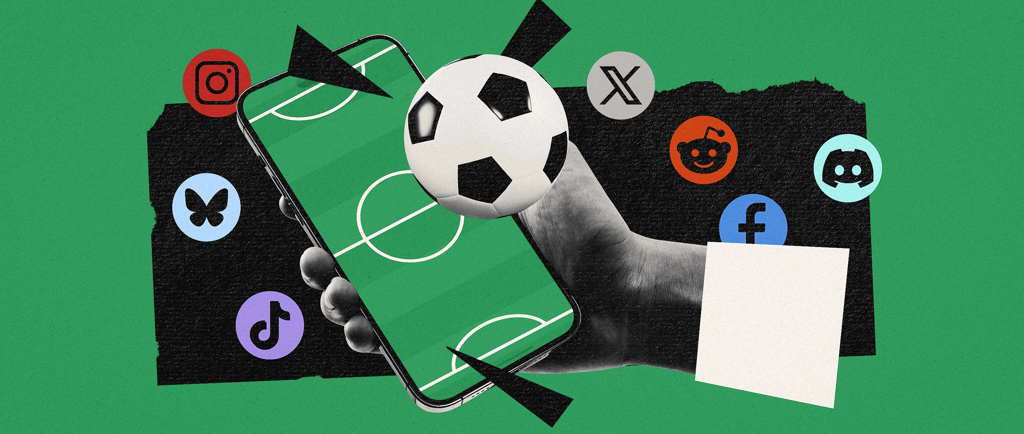How Football Media Is Shaping Fandom and Club Identity
This article looks at how football clubs are using media and technology to connect with fans in new ways. It covers how both big and small teams are using social media, creative content, and AI to grow their fanbase and stay relevant in today’s digital world.
Kyriakos Lykourgos
4/30/20255 min read


In October 2023, Real Madrid shared a video of Jude Bellingham laughing during a training session on the team’s TikTok account. This 20-second clip generated more than 11 million views in just 48 hours. The video did not show any goal, tactical play, or major announcement. It was just a simple, human moment that promoted character and connection.
Today, clubs and governing bodies do not only focus on football as a sport that is defined solely by the 90 minutes on the field, but as a space open for continuous storytelling and narrative development. Even though the sport still takes place on the pitch, the sport organisations are building their identity and loyalty through social media. The fans are interacting with their favourite clubs, leagues and competitions through reels, shorts, fan forums, comment debates and all other behind-the-scenes content.
This new football ecosystem can be very advantageous but can also bring some deeper business consequences for the stakeholders. The question is: Does this model build lasting fandom or does this run the risk of fan burnout?
1. The Rise of Football Content
Throughout the last decade we have seen clubs communicating and connecting with the fans in non-traditional ways which can be seen as radical.
In 2012, clubs primarily relied on broadcasters, television, and traditional media for exposure.
By 2020, elite clubs like Manchester City and Juventus operated full-scale media production studios.
By 2023, Cristiano Ronaldo was the first person to surpass 600 million followers on Instagram. This shows the power of the player's brand and also how the footballer was able to capitalise on his fame to build a fanbase/ following that continuously pays attention to what he posts.
Social media platforms have become real place for people to connect with their teams:
Premier League clubs generated over 13.8 billion video views across platforms in 2023.
FC Barcelona has more than 470 million followers across all digital properties.
TikTok has become the fastest-growing platform for football content, with 60% of users aged 16–24 engaging with sports content weekly.
In 2025, 84% of sports fans use social media while watching matches live. This means that teams use social media for storytelling and informative purposes before, during and after the game. These kinds of media are also used by teams when the season is over. For example during the summer (when teams are inactive), the teams keep posting regularly to keep the fans engaged.
2. Strategic Impacts
Fan Behaviour
Upside:
Fans can interact with the players and clubs daily, thus they feel more emotionally connected.
Due to the fact that younger audiences are less likely to watch 90-minute matches, short form content can keep them engaged and emotionally- driven.
Clubs and leagues can now build or promote narratives before matches. They provide much more than just scorelines, thus they create anticipation and enthusiasm.
Fans engage in a more active way, by debating about tactics, transfer rumours, and player performances across forums, comment sections, memes, podcasts and live streams.
Risk:
The constant exposure to sports related content can lead to the loss of the importance of the moment. When fans are micro-dosed with content all the time and they are exposed to the greatest football moments of every league possible, the true iconic moments can feel less special. The risk of overexposure can diminish the importance of live action.
Younger fans may have less chance of building a true deep connection with a certain sports organisation. They tend to engage on a more ‘surface- level’ interaction through memes and highlights. This can lead to weakening of long-term emotional loyalty. According to FIFA Fan Report 2023, 30% of Gen Z fans prefer watching highlights only, engaging primarily through short content.
Revenue & Marketing
Upside:
Clubs can directly monetise content by selling merchandise, limited drops, and sponsorship integrations. This is also available through social media. The fans are able to click on the merchandise they saw a player wearing on a video, and they are instantly redirected to the club’s website where they can order the product.
Sponsorship now extends beyond matchdays: Training kits, training facilities, interview backdrops, and viral videos are all lucrative assets. One example is Manchester United's training kit sponsorship with Tezos which reportedly is worth £20 million per year.
Risk:
Shifted Value:
As digital engagement grows and becomes more important, traditional assets like broadcast rights or stadium attendance will represent a smaller share of club revenue portfolios. A lot of clubs that fail to adapt, risk becoming commercially irrelevant even if they perform well on the pitch. For example clubs that are run in a more traditional way and do not see the value or prospect that the new age media can provide, will not invest in their social media market department. This will lead to the loss of possible revenue that could have been generated but also will lead to smaller clubs covering the distance or bigger clubs increasing the pre existing media relevance. According to PwC’s Global Sports Survey 2024, the total sports media rights market is projected to reach $60 billion (digital-first properties are outpacing traditional broadcasters in growth).
Global vs. Local
Upside:
Smaller clubs can outperform expectations with strong creative media strategies.
A smaller club from a less known country, can still build a strong fan engagement. Using digital media creatively can help these clubs reach a global audience. So even though these clubs will never be able to bring a player with a huge global name, they still have the opportunity to draw attention and interest. For example, Wrexham AFC has grown a global fanbase that exceeds the fanbase of other more established clubs. This is because of the club’s compelling media narrative and celebrity ownership.
Risk:
Constant exposure to elite global brands (Barcelona, PSG, Manchester United) can be a risk for local fan loyalty. Younger audiences can be drawn to the global brands and stop following/ or never build a real connection with their local club. This is because there is much more accessibility and the ‘product’ is also much better.
Player-Centric Fandom
Upside:
Players become global media brands, expanding club visibility internationally.
Fans follow personal journeys — comebacks, transfers, rivalries — making emotional ties more intense.
Risk:
Sports fans are increasingly more interested in individual athletes/ personas than in the clubs. This causes problems to clubs that may need to bring in players not because of their athletic skills but because of their brand name and following. Moreover, this also causes a problem when a player leaves the club and his fans leave with him. This runs the risk of diluting long-term club identity.
AI & Technology
Upside:
AI tools automate highlight generation, personalise content feeds, and predict fan preferences.
Hyper-personalised engagement could strengthen loyalty by delivering exactly the stories fans crave. McKinsey's 2023 Gen Z Insights found 76% of Gen Z expect brands (including sports clubs) to be "always available" online.
Risk:
Authenticity Risk:
AI can optimise delivery but not replicate the passion and unpredictability that define football. Over reliance on synthetic media , AI-written posts, AI-generated commentary risks eroding the emotional credibility that fans value most.
3. What Smaller Clubs Can Learn
In today’s media economy, creativity is more important than budget. Smaller clubs still have the opportunity to deliver compelling content and become recognisable. Even without having the world’s biggest superstars, a strong storytelling media approach can captivate fans and drive engagement. These clubs need to stay updated and pay attention to what the big clubs are doing. It is really important for these clubs to stay informed and also be agile in producing their own content and understanding the trends. This will help them stay relevant. Being digitally ‘fearless’ is a huge aspect of media success.
Conclusion
The football fandom landscape has been redefined in the new era of streaming and content. Teams, governing bodies and athletes are all using new media forms to engage fans but also to build identities.
Through this continuous content they are able to connect emotionally, reach a global audience and enjoy commercial success. However, this demands strategic care. If media is not used properly, clubs risk creating superficial loyalty and exhausting their fans’ attention span. The best mix of the two is to master storytelling and avoid losing the soul and brand identity of the club. The days that football was just about what happens during the 90 minutes on the field are far behind us, but the clubs that take advantage of this opportunity will be able to grow exponentially and shape the future.
